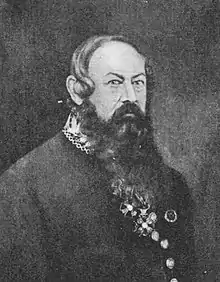Ernst Lohrmann | |
|---|---|
 | |
| Born | 30 June 1803 Übelgonne, nr. Paderborn, Duchy of Westphalia |
| Died | 17 June 1870 (aged 66) Stockholm, Sweden |
| Alma mater | University of Göttingen[1] |
| Occupation | Architect |
Ernst Bernhard Lohrmann (30 June 1803 — 17 June 1870)[1] was a German-Finnish architect born and educated in Germany but practising mainly in the Grand Duchy of Finland, where he is known especially as a designer of public buildings and more than 20 churches, many in the late Empire and Gothic Revival styles.[2]
Lohrmann also held the position of Intendant of the National Board of Public Building, following the death in 1840 of his predecessor and compatriot Carl Ludvig Engel.[2][1] In that role, Lohrmann is credited with considerably developing and systematising the Board's operations, as well as seeing through to completion many of Engel's unfinished designs.[1]
Notable examples of buildings designed by Lohrmann include:
- St. Henry's Cathedral, Helsinki
- Mint of Finland, Helsinki
- Kuopio Governor Palace (original plans, not built)
- Utsjoki Church
- Ruokolahti Church
- Söderskär Lighthouse, Porvoo
- Old Turku Prison ('Kakola')
- Villa Hakasalmi, Helsinki
- Kristinestad City Hall
- Pielisjoki Castle, Joensuu
References
- 1 2 3 4 "LOHRMANN, Ernst Bernhard". BLF.fi (in Swedish). Biografiskt Lexikon för Finland. Retrieved 30 December 2020.
- 1 2 "Ernst Lohrmann". FinnishArchitecture.fi. Retrieved 30 December 2020.
This article is issued from Wikipedia. The text is licensed under Creative Commons - Attribution - Sharealike. Additional terms may apply for the media files.